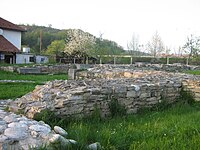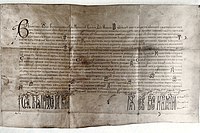Visoko during the Middle Ages
The old town of Visoki, located on Visočica hill, was a politically important fortress,[5] and its inner bailey, Podvisoki, was an early example of a Bosnian medieval urban area.
[6] Pavao Anđelić considers Visoko field to be the core from where early Slavs in the 7th and 8th century expanded the term Bosnia as a territorial unit.
[14] Additionally Latin sources do not indicate where exactly this meeting took place, other than: by river, and that monastery is located beside town Bosna.
[16] Mile is mentioned in 1244 as a place where Stephen II Kotromanić built a Franciscan monastery in honour of Saint Nicholas.
She held a stanak (assembly of nobility) in Mile, asking noblemen to confirm all of Tvrtko's rights, who was 15 years old by that time.
[18] Tvrtko Kotromanić wrote to Hrvoje Vukčić Hrvatinić on 12 March 1380 out from the royal court in Moštre (Moištri in medieval sources), which was also located in the Visoko basin.
On April 9 1428 the wedding engagement between Tvrtko II and Dorothy Garai was made and by July 31 Ragusan merchants asked the queen to stop by Podvisoki so she could receive gifts.
On August 9 Vlachs committed to Ragusan lord Tomo Bunić, that they will deliver 1500 modius of salt carried by 600 horses.
The nobility on the side of Tvrtko II held a meeting in Mile and decided to overthrow Ostoja because of his pro-Hungarian stance.
They even captured some Ragusan merchants stationed in Podvisoki, for which the Republic of Ragusa protested Sigismund, King of Hungary [21] In 1412 Vuk Kotromanić, nephew of king Ostoja, killed and stole silver from one Ragusan merchant called Jakša Bunić.
Earlier that year the same nobility had supported Ostojić in one meeting that was held at the start of 1420, but this time Tvrtko II was assisted by the Ottoman Empire in reclaiming his throne and made Visoko his royal court in 1421.
Economic activity in Podvisoki faded and the king together with the nobility went into the north-east, where they retreated into better fortified positions like Bobovac and Ključ.
[23] In these twilight years of the Kingdom of Bosnia, Thomas of Bosnia, son of King Ostoja, began persecuting members of the Bosnian Church, which were considered heretics by the Catholic Church, as a means to ensure help from Catholic Europe against the ever-growing threat of the Ottoman Empire.
The banishment of followers of the Bosnian Church from the Visoko area, a historical stronghold of theirs, led to the destruction of the local Franciscan monastery in retaliation.
In Podvisoki, a colony of Dubrovnik's merchants developed and maintained historically good relations with the Republic of Ragusa.
One such expedition found a stećak necropolis, some made in fine detail[clarification needed], including many materials, jewellery, tools, and other artifacts.
There is not much detailed information about the medieval university in the Visoko area, referred to as the place called Bosnia by the Vatican archives.
Other royal charters in correspondence with the Ragusans documents confirm that one of the residences of Tvrtko II and King Thomas was located there.
It is, however, most notable as the place where Mehmed the Conqueror, following the Ottoman conquest of Bosnia in late May 1463, issued the Ahdname to the Bosna Argentina Franciscan friar Anđeo Zvizdović, promising religious tolerance.
[26] In Biskupići, a plate of Kulin Ban dating from 1193 was found alongside the remains of his church, grave, and foundations of buildings from that period.
In the small settlement of Malo Čajno, on the ground of an Orthodox church cemetery, a plate of big Kaznac Nespina was found.
Cyrillic inscription reveals the title and name of the distinguished representative of the state administration whose task was to collect rulers revenues.






